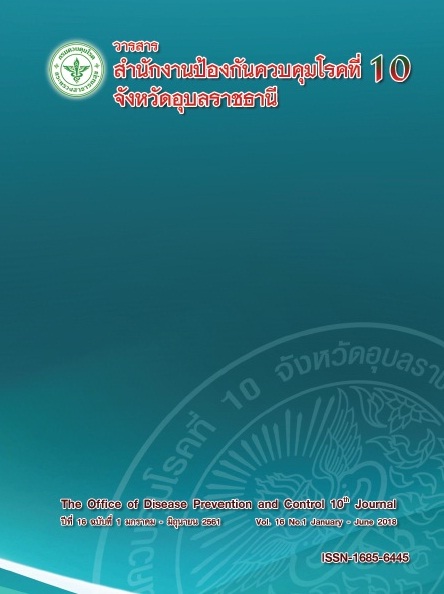ประสิทธิผลของวัคซีนป้องกันไข้หวัดใหญ่ชนิดเชื้อตายสามสายพันธุ์ในผู้สูงอายุตั้งแต่ 65 ปีขึ้นไป ในจังหวัดนครพนม: การติดตามเชิงสังเกตการณ์ 2 ปี
คำสำคัญ:
ประสิทธิผลของวัคซีน, ไข้หวัดใหญ่, ผู้สูงอายุบทคัดย่อ
การศึกษาเชิงสังเกตนี้เป็นการติดตามไปข้างหน้าในผู้สูงอายุตั้งแต่ 65 ปีขึ้นไป เพื่อเปรียบเทียบอุบัติการณ์ของโรคติดเชื้อเฉียบพลันในระบบทางเดินหายใจรวมทั้งผู้ที่มีอาการรุนแรง ที่มีผลยืนยันทางห้องปฏิบัติการระหว่างผู้ที่ได้และไม่ได้รับวัคซีนป้องกันไข้หวัดใหญ่เชื้อตายสามสายพันธุ์ ในฤดูกาลปี 2558-2560 ในปี 2558 อาสาสมัครสาธารณสุขได้ติดตามอาการไอหรือไอที่แย่ลงจากอาสาสมัคร 3,220 คน หากอาสาสมัครมีอาการให้เก็บตัวอย่างด้วยตนเองจากโพรงจมูกในแต่ละรายสัปดาห์ คำนวณประสิทธิผลของวัคซีน ด้วยสูตร 100% x (1- อัตราการป่วยด้วยไข้หวัดใหญ่ที่มีผลการตรวจ rRT-PCR ระหว่างผู้ที่ได้รับและไม่ได้รับวัคซีน) ใช้คะแนน Propensity score stratification เพื่อลดความแตกต่างของการได้รับวัคซีน พบว่า ในช่วงฤดูกาลไข้หวัดใหญ่ ปี 2559-2558 มีผู้ได้รับวัคซีน 1,666 คน (52%) ฤดูกาล 2560-2559 มี 1,498 คน (48%) เกิดการเจ็บป่วยด้วยไข้หวัดใหญ่ 14.3/1000 ประชากรต่อปี ในกลุ่มผู้ที่ได้รับวัคซีนและ 20.2/1000 ประชากรต่อปี ในกลุ่มที่ไม่ได้รับวัคซีน ประสิทธิผลของวัคซีนไข้หวัดใหญ่ป้องกันโรคได้ -4% (95% confidence interval [CI], -83%–40%) ในช่วงฤดูกาลไข้หวัดใหญ่ ปี 2559-2558 และ 50% (95% CI, 12%–71%) ในฤดูกาลปี 2559-2560 ค่าประสิทธิผลของวัคซีนไข้หวัดใหญ่แต่ละสายพันธุ์ทั้งสองฤดูกาลพบว่ามีนัยสำคัญเฉพาะ A/H3N2 ในฤดูกาลปี 2559-2560 (VE, 49%; 95% CI, 3%–73%) โดยสรุป วัคซีนไข้หวัดใหญ่สามารถป้องกันโรคได้ครึ่งหนึ่งของผู้ที่ได้รับวัคซีน
เอกสารอ้างอิง
Grohskopf LA, Sokolow LZ, Broder KR, Walter EB, Bresee JS, Fry AM, et al. 2017. Prevention and Control of Seasonal Influenza with Vaccines: Recommendations of the Advisory Committee on Immunization Practices -United States, 2017-18 Influenza Season.MMWR Recomm Rep 66: 1-20.
World Health Organization. 2012. Vaccines against influenza WHO position paper—November 2012. Wkly Epidemiol Rec87: 461-76.
Restivo V, Costantino C, Bono S, Maniglia M, Marchese V, Ventura G, et al. 2018. Influenza vaccine effectiveness among high-risk groups: A systematic literature review and meta-analysis of case-control and cohort studies. Hum Vaccin Immunother 14: 724-35.
Hirve S, Lambach P, Paget J, Vandemaele K, Fitzner J, Zhang W. 2016. Seasonal influenza vaccine policy, use and effectiveness in the tropics and subtropics – a systematic literature review. Influenza Other Respir Viruses 10: 254-67.
Lipsitch M, Jha A, Simonsen L. 2016. Observational studies and the difficult quest for causality: lessons from vaccine effectiveness and impact studies. Int J Epidemiol 45: 2060-74.
Jefferson T, Di Pietrantonj C, Al-Ansary LA, Ferroni E, Thorning S, Thomas RE. 2010. Vaccines for preventing influenza in the elderly. Cochrane Database Syst Rev Cd004876.
Osterholm MT, Kelley NS, Sommer A, Belongia EA. 2012. Efficacy and effectiveness of influenza vaccines: a systematic review and meta-analysis. Lancet Infect Dis 12: 36-44.
Owusu JT, Prapasiri P, Ditsungnoen D, Leetongin G, Yoocharoen P, Rattanayot J, et al. 2015. Seasonal influenza vaccine cover age among high-risk populations in Thailand, 2010–2012. Vaccine 33:742-7.
Dawood FS, Prapasiri P, Areerat P, Ruayajin A, Chittaganpitch M, Muangchana C, et al. 2014. Effectiveness of the 2010 and 2011 Southern Hemisphere trivalent inactivated influenza vaccines against hospitalization with influenza-associated acute respiratory infection among Thai adults aged ≥ 50 years. Influenza Other Respir Viruses 8: 463-8.
Plasai V, Lertmaharit S, Viputsiri OA, Pongpanich S, Panichpathompong U, Tarnmaneewongse V, et al. 2006. Influenza vaccination among the elderly in Bangkok. Southeast Asian J Trop Med Public Health 37: 140-4.
Praditsuwan R, Assantachai P, Wasi C, Puthavatana P, Kositanont U. 2005. The efficacy and effectiveness of influenza vaccination among Thai elderly persons living in the community. J Med Assoc Thai 88: 256-64.
Saliba D, Elliott M, Rubenstein LZ, Solomon DH, Young RT, Kamberg CJ, et al. 2001. The Vulnerable Elders Survey: a tool for identifying vulnerable older people in the community. J Am Geriatr Soc 49: 1691-9.
Goyal S, Prasert K, Praphasiri P, Chittaganpitch M, Waicharoen S, Ditsungnoen D, et al. 2017. The acceptability and validity of self-collected nasal swabs for de tection of influenza virus infection among older adults in Thailand. Influenza Other Respir Viruses 11: 412-7.
Prakongsai P. 2006. An Application of the Asset Index for Measuring Household Living Standards in Thailand.
Fleiss JL, Levin B, Paik MC. 2004. Determining sample sizes needed to detect a difference between two proportions: Wiley Online Library.
Rosenbaum PR, Rubin DB. 1984. Reducing Bias in Observational Studies Using Subclassification on the Propensity Score. J Am Stat Assoc 79: 516-24.
Flannery B, Chung JR, Thaker SN, Monto AS, Martin ET, Belongia EA, et al. 2017. Interim Estimates of 2016-17 Seasonal Influenza Vaccine Effectiveness-United States, February 2017. MMWR Morb Mortal Wkly Rep 66: 167-71.
Praphasiri P, Ditsungnoen D, Sirilak S, Rattanayot J, Areerat P, Dawood FS, et al. 2017. Predictors of seasonal influenza vaccination among older adults in Thailand. PLoS One 12:e0188422.
Andrew MK, Shinde V, Ye L, Hatchette T, Haguinet F, Dos Santos G, et al. 2017. The Importance of Frailty in the Assessment of Influenza Vaccine Effectiveness Against Influenza-Related Hospitalization in Elderly People. J Infect Dis 216: 405-14.
Baxter R, Lee J, Fireman B. 2010. Evidence of Bias in Studies of Influenza Vaccine Effectiveness in Elderly Patients. J Infect Dis 201: 186-9.
Remschmidt C, Wichmann O, Harder T. 2015. Frequency and impact of confounding by indication and healthy vaccinee bias in observational studies assessinginfluenzavaccine effectiveness: a systematic review. BMC Infect Dis 15: 429.
ดาวน์โหลด
เผยแพร่แล้ว
รูปแบบการอ้างอิง
ฉบับ
ประเภทบทความ
สัญญาอนุญาต
บทความที่ได้รับการตีพิมพ์เป็นลิขสิทธิ์ของ สำนักงานป้องกันควบคุมโรคที่ 10 จังหวัดอุบลราชธานี
ข้อความที่ปรากฏในบทความแต่ละเรื่องในวารสารวิชาการเล่มนี้เป็นความคิดเห็นส่วนตัวของผู้เขียนแต่ละท่านไม่เกี่ยวข้องกับสำนักงานป้องกันควบคุมโรคที่ 10 จังหวัดอุบลราชธานีและบุคลากรท่านอื่นๆในสำนักงานฯ แต่อย่างใด ความรับผิดชอบองค์ประกอบทั้งหมดของบทความแต่ละเรื่องเป็นของผู้เขียนแต่ละท่าน หากมีความผิดพลาดใดๆ ผู้เขียนแต่ละท่านจะรับผิดชอบบทความของตนเองแต่ผู้เดียว



